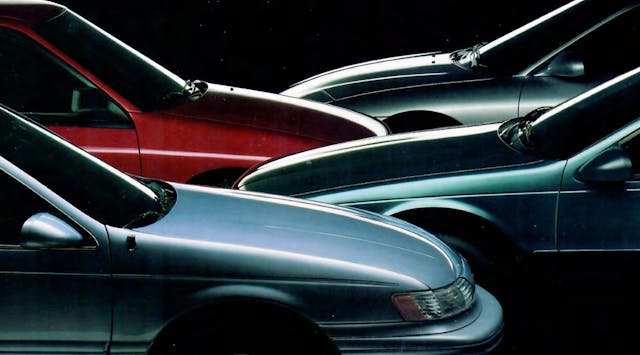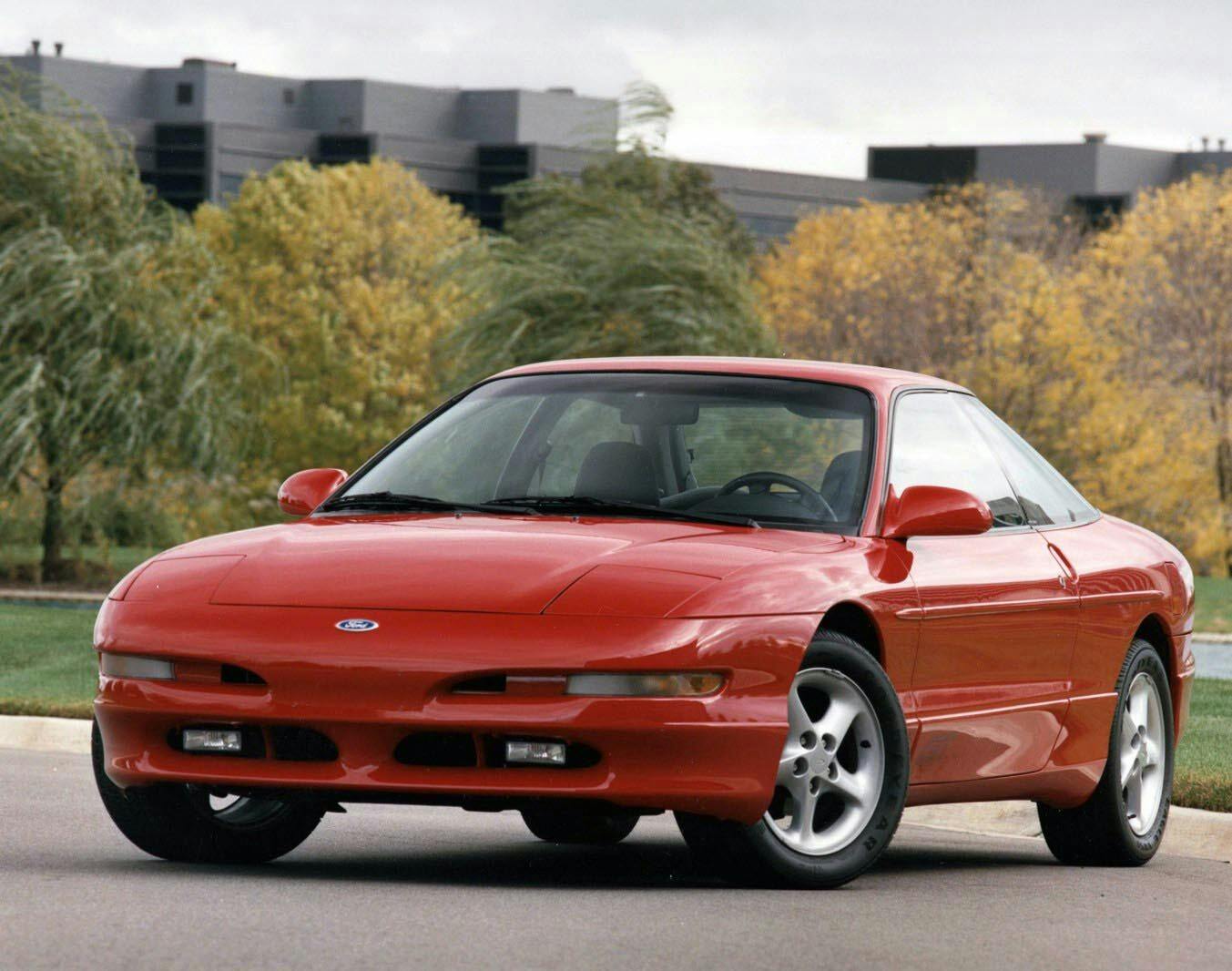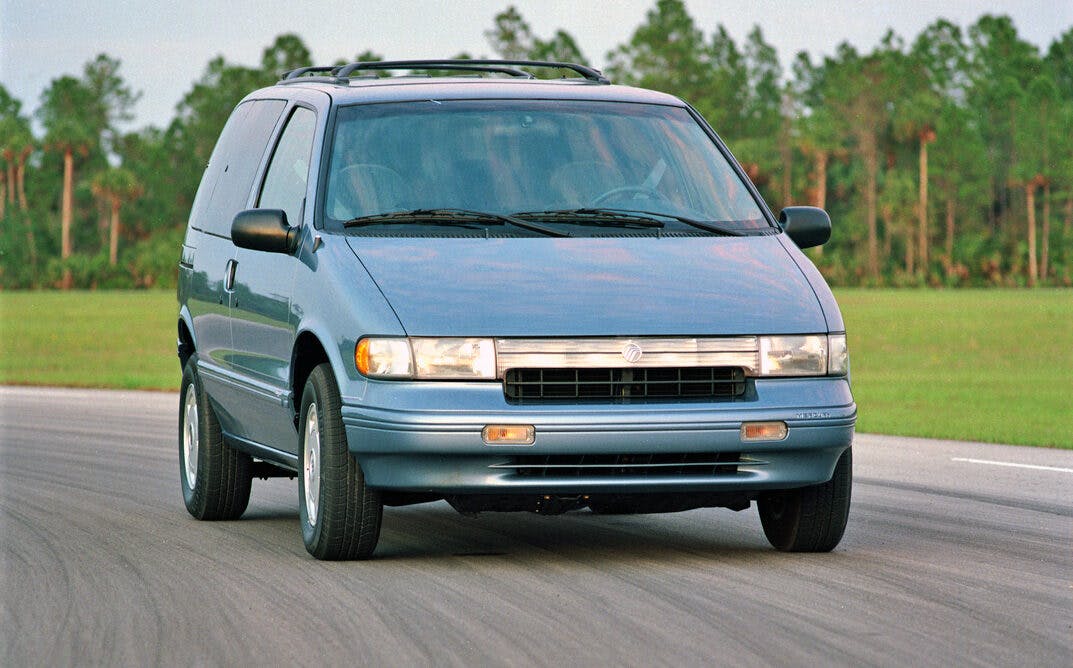Ford was interesting before globalization made its Mark
Ford’s somewhat recent decision to stop making cars (that weren’t Mustangs) was such a big deal that even franchised dealerships felt the need to write about it on their websites. Except there’s more to the story, because websites are managed by a third-party vendor, and said vendor often farms out dealership blogs to freelancers who specialize in writing Google-friendly articles. Consider this seemingly irrelevant anecdote as a passing of the buck from company to company. And then from a company to some person “no longer associated with the business.”
It’s hard to know where things originate these days, but it was far more straightforward in the past. The tide turned when Ford Jac Nasser went on a global buying spree for Jaguar, Volvo, and Land Rover in the late 1990s, forever altering the automotive landscape of Dearborn and beyond. Globalism became policy. Even Ford CEO Alan Mulally couldn’t unring the bell, though he wisely ended all that nonsense less than a decade later. In some ways, we are worse off because of Ford’s rush to globalize. And we will never recover.
Thanks to Motorweek for this trip down memory lane, when America had “full line” automakers with a portfolio of subcompacts, sedans, coupes, station wagons, minivans, SUVs, pickups, and performance cars. Annual changes were newsworthy and possibly even exciting, because money wasn’t spent elsewhere in appreciable quantities. Can you imagine Ford investing in a tech company—with no experience making cars, which had nevertheless bought an old Mitsubishi factory and was making its own pickup trucks, etc.—back in 1993? Getting involved with Aston Martin back then was enough drama for most.
Compared to Ford’s current portfolio, stripped down of anything even resembling inefficient use of its funds, this 1993 snapshot had an astounding eight different platforms for sedans, coupes, and station wagons of various sizes. And every platform had a plethora of four-, six-, and eight-cylinder engines in tow. Even better, most were designed and made in America North America, with little parts interchangeability elsewhere.
As Motorweek details, the 1993 model year resulted in incremental changes ranging from forgettable (a pointless chrome grille on the “Aero” Crown Victoria) and regrettable (the sin of an automatic in a Taurus SHO, sales increases be damned!) to downright collectible (the arrival of the Mustang Cobra). A new Ranger also came out, the same one that died 18 years later when the factory shut down. It was a sign of things to come, as Ford’s global partnerships were gaining prominence, foreshadowing a future with less control from the Detroit mothership.
But the products behind these partnerships were still curiosities; they were not the norm for multiple continents. They had modest long-term utility for retailer, consumer, and stockholder alike. Although the Nissan Maxima was a fantastic sedan by most metrics, it didn’t necessarily make for a great Villager minivan for Mercury’s long-term fiscal health. One of the few Detroit/Import mashups that is generally well regarded (by gearhead and bean-counter alike) was the Ford-Mazda love affair that birthed the Probe sports coupe. Which is a shame, because their Festiva offspring was a surprisingly fun and relevant South Korean import … whenever high gas prices punctuated its need for existence outside of CAFE mandates.
But the world of Ford for 1993 wasn’t just a case study in incremental improvements, joint ventures, and a new Ranger. The Motorweek video dedicates a large chunk of time to personal luxury, a wholly American genre never to be seen again. The personal luxury car was first made by Edsel Ford as a Lincoln Continental, then by William Clay Ford as a Continental Mark II, then pragmatically crafted by Lee Iacocca as the Mark III. The Conti was such a success that Ford cemented the personal luxury genre for years to come. And this next/final generation bordered on being a spare-no-expense design, an heir to the Continental throne with some of the best stuff to come from America at the time.
The eighth-generation Mark Series even splashed the cash for Jeff Goldblum voiceovers—before he became the voice of Apple Computer. But it goes deeper, as the Mark VIII’s block engine was cast in the same place that did Ferrari motors. There was a fully independent suspension with enough aluminum components to make a C4 Corvette blush. Heck, even the differential housing was made out of aluminum. And that four-camshaft, 4.6-liter V-8 was given to Lincoln three years before the Mustang Cobra got it in 1996, a full 18 years before morphing into a 5.0 Coyote. It may not be cutting edge (as Mercedes and Lexus beat Ford to the punch), but it was the start of something quite special for enthusiasts.
And haters can bite their badge-engineered tongue, as none of this stuff was available on the smaller Thunderbird platform.

Clearly I have bias in the matter, as my daily driver is a Mark VIII LSC. I know its dirty little secrets, things you can’t see behind those almond eyes that occasionally bore troublesome HID light bulbs. The flaws are obvious, but the timelessness endures: Aside from more safety equipment and the glaring lack of an 8-speed automatic transmission, there’s precious little a new luxury vehicle offers that a well maintained, lightly modified, 30-year-old Mark VIII cannot provide. (The same applies to many vehicles from the 1990s, I might add.)
And when the Mark VIII was new? Good luck pulling ahead of it, unless you were in a Corvette or a Supra Turbo. Its straight-line thrust compensated for the poorly matched set of sway bars, the nerdy ride height, and the BMW-like vinyl coatings in lieu of traditional wood-grain trimmings. A great first effort, but it sadly points to Ford’s lack of commitment just a few years after this episode of Motorweek hit the airwaves. Introductions like the 1993 Mark VIII will likely never see the light of day again: American heroes (that aren’t Tesla or Lucid) rarely have easy-to-spot American DNA with very obvious pros and cons against their foreign competition.
We now live in a world as homogenized as a NASCAR race field. Modern product introductions are a plain vanilla crossover utility–themed hellscape of two-box designs with four-cylinder hearts. The only difference is that some automakers have a better topping bar for your sundae, packed with turbocharging, hybrids, and a variety of luxurious sprinkles. While cars like the Lexus LC, specialty trucks, and every Mustang have merit, the landscape has still changed dramatically since 1993.
Or perhaps the contrasts between 1993 and 2023 aren’t worthy of such a rant. Maybe rose-colored glasses are just that. So please, dear reader, tell me which automaker makes the best 2.0-liter turbocharged engine for a crossover? Because I’d love to know.
***
Check out the Hagerty Media homepage so you don’t miss a single story, or better yet, bookmark it. To get our best stories delivered right to your inbox, subscribe to our newsletters.








Ford was much like GM in that they had good engineers but too often never had management thstveould support the ideas snd tech properly.
So many of their issues stemmed from being under funded. This lead to quality issues and problems
The 5.0 kept Ford afloat with a solid reliable engine in the Panther and Fox. All the other engines snd platforms suffered lack of development.
My last two Fords suffered bad paint, bad engines, numbers or quality issues. Heck the rear sway bar was falling off my T bird when new.
In place of buying Jag and Land Rover they should have invested in their own quality.
The isdue st Ford too was there wass and is still too much Ford in Mercury and Lincoln. You want more money don’t make my Lincoln look like a T bird.
Three new manual SHO’s, 90, 93 and 95. The slushbox was indeed blasphemy and was the beginning of the SHO end. Would buy a nice one in a heartbeat. My boss in 95 got a new LSC. Downside: MN winters. Great rig but after a year he traded it for one of the first 4 door Tahoes. I have an old car neighbor who has a project going on using the LSC motor, and maybe the rear suspension. Haven’t visited him for awhile…
Great memories Sajeev! Ford seemed way way ahead of GM then. And my SHO’s were being paid for by someone else (car allowance)!
GM stumbled a lot back then and Ford sure looked like it was doing better, both in terms of many products and in terms of sales/market share. Anyway, glad you enjoyed the article…and remember the the 3.2-liter from an automatic SHO makes the manual even better!
If I recall the SHO engines were Yamaha not really Ford designs?
Also these limited run cars did not pay the bills. The regular Taurus did. After the first gen they styling went sideways and the quality did not improve. GM, Ford and Chrysler all stumbled a bit with a few highlights in this era.
The SHO Mustang was one no one ever got. It was a Turbo 4 that still was not right and cost more than the 5.0?
The SHO was a Yamaha like Chevy LT-5 was a Lotus, sharing a common architecture with the 3.0 Vulcan engine. A limited run car that provided a halo effect just like…well, like a ZR-1 but with better sales.
SVO Mustang, not SHO. There was nothing wrong with that motor aside from the fact that Ford de-tuned it to ensure it wouldn’t spank the 5.0 in a straight line and the corners. But that was almost 10 years before this particular moment in time.
I would agree. The Thunderbird Turbo coupe or the later SC. The Mustang SVO, the Taurus SHO, The Probe GT, the Lincoln MKVII and MKVIII, the Merkur XR4Ti. All likeable and often more interesting than their other domestic competitors. Too bad the bean counters have cheapened out excellent cars with crappy parts.
Great Article, Sajeev! While the BMW interiors may have been higher quality than the Lincoln Mark VIII, I would much prefer to own the Lincoln than a ’90’s era BMW. I’ve owned a number of Fords and BMWs from the 1980’s and ’90’s and while I prefer the BMWs during the ’80’s, I much prefer the Fords by the 1990’s. Most Fords of the 1990’s were high quality and fairly easy to repair, while most things German became gratuitously complex and mechanic unfriendly by then.
Thank you for your kind words Stephen. I mostly agree with you, my only issue with the Lincoln interiors are the thinner/cheaper plastic trim parts than BMWs…but that’s only because I have to take things apart on a regular basis after my Mark had its 15th birthday. If I owned it new, the interior would be excellent.
The best crossover 2.0 liter turbo 4 is…none. They all suck. Put one on cruise bucking a headwind. Cruise senses a need for more throttle, applies it, cruise reacts faster than the turbo and believes yet more throttle is needed, trans downshifts, turbo spools up, now you’ve got too much added power. Cruise senses the excessive speed increase and backs off the throttle. The cycle begins again. Lather, rinse, repeat. It’s like I was back riding with my grandfather in his 62 Mercury, who used the accelerator like the car was a pump organ. Didn’t like it then, don’t like it now.
I also have a Mark VIII and love it. It is stylish and more sleek that many newer cars. I’m happy with the performance although it would be left in the dust by more high tech cars. It’s been reliable and other than the air suspension that I upgraded with Strutmaster springs, my only complaint is the headlights. I cannot understand why the same 9005 bulb is used for both low beam and high beam. It’s a 94 so the HID system wasn’t available. But I’m used to it and don’t drive at night very much anymore.
If the reflective material inside the headlight is gone that’s the biggest problem you got, as they weren’t bad when they were new. Not that they were great, mind you. I drove a Mark with good reflective coating and higher wattage bulbs with headlight relays and the output was pretty good.
I figured out how to put LEDs into an HID headlight and get the geometry right…but that’s a whole ‘nother story.
I’d like to see that write-up sometime as I’d like to retrofit an LED headlight bulb for my Ranger. I’m afraid I’d blind people and honestly, every time I drive at night now I’m blinded by someone who is running an LED blub in a halogen lens and it’s annoying.
Making such a writeup is dicey because they are illegal and probably never will be legal. If you have a pre-93 model with glass lights, you can, however, get Hella glass lenses and the H4 LED from Sylvania thats legal for use in Germany. Being legal in Germany is close enough, and you won’t blind anyone in the process. I will go into some detail about the Mark VIII’s LED swap in a future episode of Project Valentino.
I’ve heard several interviews to date of the ever elusive John Coletti who if your any kind of a Ford fan and in particular a Mustang fan, you’d certainly appreciate. What i took away from these interviews was that John’s boss gave him cover in many of the extreme product decisions he made, and his team executed. He and his team saved the Mustang when the Probe was planned as the replacement. His group birthed the Mustang Cobra of that era, along with many other creative product ideas. Some made it into production, many did not. As he’ll tell you, many of the projects that saw the light of day, were based upon “sunset” models. This of course made development timelines incredibly short. He tell the story of Paul Newman who at the time was a partner in the Newman/Haas Racing team and a station wagon fan, that they should build a SHO Wagon! They did a prototype, but unfortunately, it never saw daylight.
The cool things can happen if you have folks that are willing to buck the system, and have some operating room to make things happen. In Coletti’s case, he had the cover, he put together a great team, and they produced exciting, fun to drive products.
Sometimes I think about how Coletti managed to make the stellar 2003 Cobra a production vehicle and I equate it to being on par with an act of God.
The Big 3’s problem is labor costs. Even more so now after this recent labor agreement. You can’t make a profitable Fiesta or Taurus when you’re paying 50% more than non-union shops.
And it’s why base model single cab short bed F-150s are $43k now.